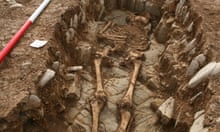A stretch of Hadrian’s Wall, believed to be 1,900 years old, has been uncovered in Newcastle city centre during routine work on a water pipe.
The three-metre structure is believed to have been built during the earliest phases of the historic Roman wall, stretching back to around AD120. The discovery was made about 50cm below ground by workers replacing a water main under one of Newcastle’s busiest roads.
It had been known that Hadrian’s Wall ran through Newcastle as part of its 73-mile stretch from Wallsend on the River Tyne to Bowness-on-Solway in Cumbria. Its exact location, however, remained a mystery.
Workers from Northumbrian Water uncovered the structure on West Road near the Two Ball Lonnen roundabout just outside Newcastle city centre. A “buffer” would be installed around the historic find to allow waterworks to continue, the company said.
Philippa Hunter from Archaeological Research Services said: “Despite the route of Hadrian’s Wall being fairly well documented in this area of the city, it is always exciting when we encounter the wall’s remains and have the opportunity to learn more about this internationally significant site.
“This is particularly true in this instance where we believe that we uncovered part of the wall’s earliest phase.”
The newly discovered stretch of wall was constructed using large blocks of stone, allowing historians to date it back to the earliest days of the build, as later stages used smaller pieces.
The first sections of the wall are believed to have been built in around AD122, when the emperor Hadrian visited Britain and constructed what became the Roman empire’s north-west frontier for the next 300 years.
Graeme Ridley, a project manager at Northumbrian Water, said: “It is amazing that we have been able to make this brilliant discovery, and we are glad to be working with Archaeological Research Services to make sure that it is properly protected going forwards.
“This is an incredibly special part of north-east heritage and we are honoured to be a part of it.”
Hadrian’s Wall is the most visible and best-known land frontier of the Roman empire, with parts of it visible for miles across northern England. The structure was even famous in its own day, inspiring souvenirs such as small pans bearing the names of its forts. The wall was made a Unesco world heritage site in 1987.










